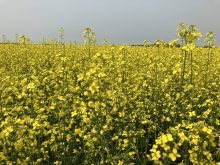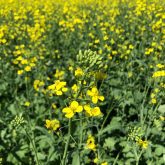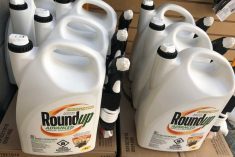Canola is king across Alberta — and there’s no reason to think it won’t have a long and healthy reign.

“Canola offers a leading and consistent mix of superior agronomics and strong demand,” said Greg Kostal, president of Kostal Ag Consulting.
“Yeah, it has its ups and downs, and there’s little micro-reasons for it. But if you filter out all the noise, there’s a growing demand.”
The market for Canadian canola is on the rise, while demand for wheat for human consumption is “relatively flat,” growing only as incomes and populations grow.
“If our (canola) crop were one million or two million tonnes bigger, I wouldn’t have a problem finding a demand slot for it,” said Kostal.
“That doesn’t mean prices need to giddy-up and go, but we’re almost in a position at a 21-million-tonne crop size threshold where more canola is not more price negative. It just caps how high we go.”
A visit to any crush plant shows just how strong demand is.
In mid-October, Canadian canola crushers were processing near-record levels of the oilseed, topping out at 204,820 tonnes — only a little short of the 208,268-tonne weekly record set in March. And that happened even as margins were $40 a tonne lower than year-ago levels.
“I think that’s a strong testament to the companies involved feeling confident that not only is off-shore demand strong, but also there is a consistent push to provide the supply,” said Kostal.
While the crop’s profitability is obviously its biggest attraction for growers, strong and consistent demand is another big plus.

“Farmers depend on it for a big chunk of their income,” said John Guelly, who farms near Westlock.
“It’s a really handy crop — it’s very liquidable when you need some cash flow. It’s pretty easy to just pick up the phone, sell some, deliver it, and pick up a cheque.”
Industry investment in crush plants over the past five years has helped with that, Guelly added. “We’ve got a lot of domestic infrastructure in place. There are a lot of crush plants across Western Canada now.”
And, knock on wood, it may even get better.
China is starting to transition from soybean crushing to canola crushing, converting at least two — and possibly three — soy-crushing plants to process canola instead.
Read Also

Farming Smarter receives financial boost from Alberta government for potato research
Farming Smarter near Lethbridge got a boost to its research equipment, thanks to the Alberta government’s increase in funding for research associations.
“You can’t talk about canola — or any markets, for that matter — without China,” said Kostal. “China has been a steady market, but that just opens the door for another incremental leap in canola.
“When you look at what China imports out of Canada, it has been consistently around four million tonnes for the last three years. That could catapult us to maybe five million tonnes.”
‘Room for growth’
But China is just one potential growth market, Kostal added.
“As long as Canada has the export capacity to move it — which we have been — China is just one demand growth variable that sits very well with the Canola Council of Canada’s 2025 target of 26 million tonnes,” he said.
“Where China can come and swing a big bat, all these other little places take 50,000 tonnes or 100,000 tonnes here and there. It all adds up.”
Kostal also sees possibilities for more canola going into the U.S. biofuel sector, although for Guelly, the biodiesel market is “a tough one.”
“One never knows these days what the Americans are going to do,” he said. “I’m not sure that the growth of biodiesel in Canada is necessarily going to get much larger than it is now. It has its place, and I think it’s holding its own. But what the Americans do probably has a much larger effect on it than what Canada does.”
And there will be “speed bumps and hurdles” in the canola market, said Kostal.
“I’m not concerned, but you can’t just put the blinders on and think everything is going to be good forever. You do have some of these hiccups you have to contend with.”

Even in growing markets, supply and demand don’t move in unison, he said, and gyrations in both palm and soyoil markets affect canola.
But Guelly, too, sees canola’s Cinderella tale continuing to get better.
“Canola oil certainly has room for growth,” he said. “There’s a lot of other countries out there that are still not using as much canola oil as they could. So market-wise, I think there’s a lot more opportunity out there.”
Alberta Canola’s upcoming Powering Your Profits series will help producers pinpoint some of those opportunities, by “getting people thinking in miles instead of feet,” said Kostal, who is speaking at three of the 12 province-wide events running from Nov. 14 to Nov. 23. (For details, go to albertacanola.com.)
“Anybody who’s in Western Canada can have a bit of a backyard, local bias,” said Kostal. “What I hope to do is elaborate on some of the bigger-picture trends that provide a global perspective to complement or augment the domestic thinking.”
These free one-day workshops will focus on three key pillars — agronomy, marketing, and management.
“It’s probably one of the best meetings of the winter,” said Guelly, who sits on the Alberta Canola board. “There’s a lot of great information packed into one day, and it’s always something pertinent to canola growers.”
Kostal agrees.
“If you can get a couple of big-picture points to better understand the risk and reward of certain decisions, you’re going to leave a better-informed producer.”















